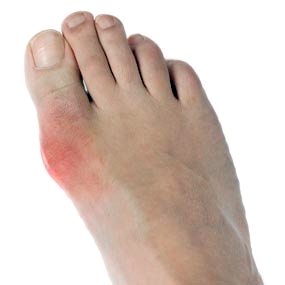My first experience with gout came as a complete surprise at the age of 25. I woke up in the middle of the night with my right big toe joint throbbing with pain, even the covers pushing down on my toe were too much. At the time I had a very faint idea of what gout was and certainly did not assume this was the case for me or even think of it as a possibility. I thought gout was something old and sick people experienced, not fit and healthy young men like me!
ABOUT ME
First Experience With Gout
I still had no idea what had happened as I hadn't injured my foot but was in severe pain. Bending my foot was such agony that I couldn't put a shoe on and had to wear sandals. I visited a doctor and she quickly gave me the diagnosis of gout. The doctor asked if anyone in my extended family had ever had gout; I then remembered hearing that gout ran in the family on my father's side.
The culprit for my first attack was the big hunk of leftover roast that I had eaten the night before. The large amount of purines in the meat had overloaded my body with uric acid and brought on my first full-fledged gout attack. Needless to say I did not want any gout attacks again. I had suffered some pretty bad sprains to my ankles before and gout was far worse.
One lesson learned from that first experience was the importance of staying hydrated. I got much better about drinking water after that and didn't have another full-fledged outbreak for over ten years. There were a few near-misses over that time, but the telltale pain in my right big toe usually gave me the warning to start drinking lots of water and thus avoid the gout attack.

Middle Age: More Frequent Gout Attacks
My next major attack occured at the age of 37 during a stressful move to a new home. I had been eating poorly and not drinking enough water for several weeks. The night before the attack I ate a big pastrami sandwich at a diner and had some beer. The attack was really bad, my foot was like a board it was so stiff and swollen. The doctor gave me the anti-inflammatory medications Colchicine and Indomethacin to get over the attack.
My gout was pretty quiet for the next three years or so, but starting around age 40 my symptoms began to become more chronic. I didn't realize it at the time but the extreme soreness in my knees after running or tennis was not just 'getting older' but rather a low-level inflammation in my feet, ankles, and knees. Also during this period there were times when my right knee would become very painful and stiff if I squatted all the way down too much or overused the knee. At the time I thought I had somehow injured the knee but in retrospect it was clearly gout-related.
The final stage up to now (I'm age 42) came this year when I twice had strong gout attacks from working in the yard and not getting enough hydration. I also had to realize that drinking 3-4 beers at a time several days a week just could not continue. My condition prompted me to do much more reading and research to understand gout and how to treat it, and also to try some of the home remedies described in this site such as celery seed extract and tart cherry extract. I have also purchased a uric acid monitor to track my uric acid levels.
As of writing this (November, 2016) my gout symptoms seem to be mostly under control but I've had to make a lot of adjustments. My diet has changed quite a bit over the last five years or so; I now am for the most part vegetarian (occasional poultry), eat very little sugar, and have had to reduce my alcohol consumption considerably.
Treatment Results with Natural Remedies
Taking Celery Seed Extract for the first time was exciting, at the time I was experiencing a lot of gout-related knee pain and the celery seed supplements created a distinctly good sensation in my toes and ankles and the pain and swelling did go down and have mostly stayed away. I would say that celery seed and tart cherry have been very good for helping inflammation but not so much for lowering my uric acid. However I have only been taking them for about six weeks and apparently it can take several months for celery seed to begin lowering uric acid.
I'm still early in my progress of tracking my uric acid levels but would say there has been some success. Just over the six weeks I have had the monitor I have begun to see readings below 6.0 mgdl, which is considered the target uric acid level.
I have also been using baking soda when I have any pain in my primary gout joints. It seems that baking soda helps to quickly lower uric acid to stop a pending attack but should not be taken for long periods as bicarbonate of soda is really quite a powerful substance when released in the body. The first time I tried baking soda to relieve gout symptoms I put too much in the glass and did not adequately dissolve it. It wound up burning my throat and making me sick for several days.
Every gout case is different and every gout sufferer will need to try different approaches to controlling their condition. One of my goals has been to not take a medication and to try to control symptoms with hydration and natural remedies. It has been a process of trial and error and I am still in the early stages.